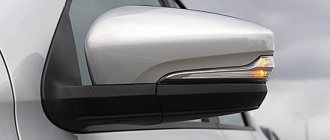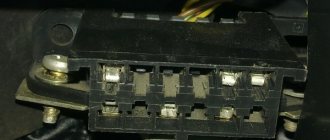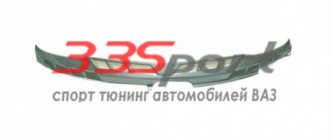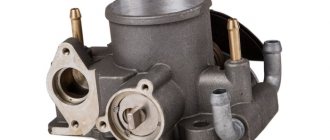April 16, 2020 Lada.Online 49 686 9
We previously wrote that from July 2022, AVTOVAZ changed the supplier of air filters for the Lada Vesta engine. However, this was not limited to replacing the filter. Along with another filter for the Lada Vesta family of cars, the plant began installing a new engine intake system. There are no official statements about the purpose for which this was done. Car enthusiasts tried to figure out the reason for the design change on their own.
How to distinguish
You can’t tell the difference in the configuration; it’s the same for both sets:
- Upper half-body (analogue 8450032859)
- Lower half-body (analogue 8450032858)
- Air intake (analogue 8450032837, now comes with a mesh!)
- Hose (corrugation) of the inlet pipe (analogue 8450032835)
- Connecting pipe for air intake (analogue 8450032838)
- Bolt m6x30 - 6 pcs (analogue 7703008226)
The main difference is in the texture of the plastic.
The Chinese intake (SalMan) has smooth plastic in the upper half-body, while the Syzran intake has rough plastic (shagreen). Accordingly, each set has its own fixing frame (more about the frames).
What is the difference between cold intake kits for Vesta made in Syzran and China (Salman) in the video:
What do you think, which cold intake kit for Vesta is better?
Source
Engine detonation dampening system
To prevent engine failure as a result of prolonged detonation, the ECM adjusts the ignition timing.
To detect detonation, the system has a knock sensor.
The controller analyzes the signal from this sensor and, when detonation is detected, which is characterized by an increase in the amplitude of engine vibrations in a certain frequency range, it adjusts the ignition timing using a special algorithm.
Adjustment of the ignition timing to dampen detonation is carried out individually for the cylinders, i.e. it is determined in which cylinder detonation occurs, and the ignition timing is reduced only for this cylinder.
If the knock sensor malfunctions, the corresponding malfunction code is entered into the controller's memory and the malfunction indicator turns on.
In addition, the controller at certain engine operating modes sets a reduced ignition timing, which eliminates the occurrence of detonation.
Articles
From July 2022
Vesta received a new air intake and purification tract:
- 8450020039 Inlet pipe hose assembly (s/o 8450006394)
- 8450031940 Air filter housing assembly (supplied complete with filter element)
- 8450033130 Engine air filter (previously used 165460509R)
- 8450031941 Resonator assembly (noise muffler)
- 8450031942 Air intake
At the end of 2022
AVTOVAZ presented the updated Vesta with a Renault-Nissan engine and a CVT. On this version of the car, the intake resonator was removed, and instead a simple intake pipe was installed, consisting of two parts 8450032994 and 8450031942.
Features of the fuel system of Lada Vesta and XRAY
The fuel system of Vesta and XRAY differs from similar systems of other Lada cars (for example, Grants, Kalinas or Prioras) and is more similar to the design of the 2009 Renault Logan. For example, Vesta/XRAY does not have a remote fuel filter, which everyone is used to seeing near the gas tank. Let's consider all the features of the fuel system of the new AvtoVAZ product.
| Fuel (according to GOST R 51866-2002 (survey) | "Premium Euro-95" | |
| Fuel tank capacity (real), l | 55 | 50 |
| Fuel module | 8450008680 / 21800113900900 | 17202 2047R |
| Fuel rail (VAZ-21129 and 21179/H4M engines) | 2190-11139009 | |
| Operating fuel pressure in the fuel rail, kPa (bar) | 364-400 (3,7-4,0) | |
| Fuel injectors | n.d. | |
Elements of the Vesta/XRAY power system: 1 – fuel tank filling pipe; 2 – fuel tank; 3 – rear steam pipe; 4 – rear fuel pipe; 5 – fuel pipeline tube; 6 – steam pipe; 7 – front fuel pipe tube; 8 – injector ramp; 9 – front tube of the fuel pipeline; 10 – adsorber; 11 – front steam pipe; 12 – steam pipe from the adsorber to the adsorber purge valve; 13 – adsorber purge valve; 14 – steam line pipe from the adsorber purge valve to the intake module.
How is the new design better than the old one?
User gagarinec expressed his guesses. He assumes that the case is an old model
does not allow the filter to fit tightly into place, which causes air leaks, which can be identified by a dark mark on the filter seal:
New air filter housing
plastic amplifiers inside the intake window have been removed. Now the amplifier has been incorporated into the design of the filter element, making it resistant to deformation. As a result, the seal is pressed evenly and tightly, eliminating air leaks. Perhaps this was the root cause of the transition to a new air filter housing design.
At the same time, the plant redesigned the resonator
. Having compared two resonators (old and new samples), it was revealed that the latches on the resonator nozzle, which secure the resonator in the filter housing, are quite thick and rigid. The snapping into the housing occurs thoroughly, but it is difficult to pull the N/O resonator back out of the housing. The lower latch, being the narrowest, simply breaks at its base, because it lacks elasticity. The s/o resonator was better in this regard. The plastic was thinner and more pliable. The latches were more elastic and it was easy to insert/remove the resonator from the case if necessary. By the way, the old-style resonator could produce extraneous noise.
Air filter comparison
old and new samples (different filtration areas):
Conclusion
: It seems that AVTOVAZ noticed and eliminated shortcomings in the Renault design by developing its own version of the housing and filter element. The financial component cannot be excluded either, because The filter element from BIG is much cheaper on a car factory scale than MANN.
About interchangeability
: the new filter housing is absolutely identical in size to the old one and therefore fits perfectly with the old resonator. We can conclude that the new resonator will also fit the old filter housing.
By the way, during the operation of the Lada Vesta Sport, it was also noted that the filter may not fit tightly to the body, a gap is formed, and as a result, air leaks appear. To solve the problem, the intake is being modified.
Source
With your own hands
1.
elite83 decided to approach the problem
comprehensively
. He determined that the bending of the engine air filter lip was due to a missing rib. The filter was modified (strengthened) and he applied a strip of hot-melt adhesive to the top of it.
He further noted that the protrusion in the area of the wire block is too high and rests on the filter, as a result of which it lifts. He corrected this problem by bending the filter lamellas.
In order for the filter to fit tightly and hermetically into the housing, he made an additional rim on the filter housing using silicone (applied sealant and a plastic card with a cutout, made the required layer - approximately 3 mm)
The filter housing itself was also strengthened (using a vibration isolator).
2.
ivonsoyu decided to prevent the filter from deforming
using wire
. To stiffen the frame, he stitched the ends of the filter with it.
3.
mrlex decided to modify the housing to improve the fit of the filter in it.
To do this, he screwed two plates
into the body using a pair of self-tapping screws.
Is the intake cold?
To check this, it was decided to conduct tests. Two Lada Vesta cars with 1.6-liter engines took part in the test. The first has a standard intake, the second has an intake from Vesta Sport. These cars drove along the same road on the same day. All engine readings were recorded using a special program.
The intake air temperature on the standard car was 42-47 degrees, on the modified car - 44-50 degrees. Thus, in practice, the cold intake from Vesta Sport did not turn out to be such
. In addition, no difference in dynamics was noticed; all changes were within the error.
Measurements
The owner of Vesta Autosnz74 decided to compare the old intake system of Vesta (until 2022) with the intake system of the CVT Vesta. Measurements were carried out on the same sections of the road using an ELM327 adapter and software on a smartphone.
1. Fuel consumption.
Measurements were performed on cruise control:
| VAZ inlet | Intake HR16de | |
| 60km/h | 5.1 l. | 5.3 l. |
| 80 km/h | 5.9 l. | 5.8 l. |
| 100 km/h | 6.8 l. | 7.0 l. |
2.
Combination and comparison of data with ELM327 at a speed of 60 km/h, as well as acceleration to 100 km/h and 150 km/h. The difference was within the margin of error. A person will not even feel such a difference.
3.
Acceleration time from 0 to 100 km/h.
I used the stopwatch because the application was glitchy:
| VAZ inlet | Intake HR16de | |
| 1 race | 12.93 s. | 12.81 s. |
| 2nd race | 12.88 s. | 12.80 s. |
| 3rd race | 12.89 s. | 12.85 s. |
4. Check-in with XRAY 1.8 (AMT 1.0)
from place. Both times the two cars drove almost exactly, Vesta 1.8 AMT 2.0 was slightly ahead at the moment the robot switched, and at a speed after 130 km/h XRAY was already starting to catch up and overtake.
Is there a power increase?
And in one of the reviews of the Lada Vesta Sport, an Autoreview expert noted that this cold intake alone gives about 6 hp increase in power. Is there an increase in power on the 1.6-liter engine?
To check this, the Lada Vesta 1.6L was tested on a dyno before and after installing the intake from Vesta Sport. Power measurements showed that the amount of horsepower before and after modification did not change
(115 hp left).
Source
Intake manifold (receiver) Lada Vesta: disassembly instructions
The engine’s task is to correctly use the fuel-air mixture that the injector (or carburetor) formed for it, show the available horsepower to its owner and release exhaust gases.
The intake manifold, or receiver, is the lungs of the Lada Vesta car. It is important that the air mixture is supplied evenly to all cylinders of the engine - this will ensure uniform operation of all cylinders. The intake manifold supplies the mixture evenly. On the Lada Vesta car, this part is slightly different in shape from previous models. The price of the part is from 2,000 to 6,000 rubles. Removal and replacement will cost from 1,500 thousand rubles. Read the article to the end and understand: how the work works, removing the intake manifold on a Lada Vesta, its main malfunctions! The intake manifold of a Vesta car is responsible for ensuring that an equal volume of the fuel-air mixture enters each cylinder in a proportion as close as possible to that given by the injector. But the exhaust manifold “takes” exhaust gases from the combustion chamber and discharges them into the exhaust system through the catalyst. The actual power generated by the engine will depend on how little exhaust gas remains in the combustion chamber and whether the fuel-air mixture is equally distributed among the cylinders.
Cold intake from Vesta Sport
Vesta Sport produces 145 horses. but at what cost - the expense is terrible. but the engine still had no torque. and even with just a cold air intake it’s a pitiful effort. Nothing can be achieved from the current engine architecture.
Lada Vesta SW Cross 1.8 5MT Luxe Multimedia Mars 2022. was.
I was 12 and a half. when driving quietly. If you keep the engine constantly under torque, it is unlikely to be below 15.
Lada Vesta SW Cross 1.8 5MT Luxe Multimedia Mars 2022. was.
But how much space is freed up, a typhon from a locomotive can be stuck in, which is not a plus
Has anyone upgraded the cold intake system in a way other than from Vesta Sport? At the standard pipe, the air inlet rests on the radiator, i.e. The engine is powered by burning air, which has a low oxygen content, which makes the mixture lean. Accordingly, if you move the air intake to a cooler place, for example in front of the battery, the mixture becomes richer and at the bottom the car becomes faster and without failures.
I looked at it again today on purpose. The fence is implemented in front of the radiators on the side, and not as you write. The air is as hot as it is warm outside. The battery won’t get any colder. Fixing and rotating a fence is not difficult and not the most important thing. It’s a good idea to increase the area of the filter and the passage of air. The kits are expensive and in short supply, but I plan to do it in the next month. Just to make it easier for her to breathe. All the previous ones had larger filters, it seems to me that even the Kalinovsky filter is larger.
I feel like the jerking has disappeared in 1.2 gear. The car became more responsive when you press the gas pedal. There is always enough air now. In terms of the temperature of the incoming air, there is no change on the highway; in the city it may be a little hotter, but the difference is not so obvious. Because The entire intake system also got hot before. After 3t. rpm there was a roar like a sports car.
Work: I only pulled out the original box with the filter, unscrewed the adapter from it (with 2 bolts), which is then inserted into the rubber corrugation. This adapter was screwed directly to the Ford filter (all seats fit perfectly) and back into the corrugation to the throttle. Place the corner in the standard filter mounting location.
So far I like the changes. And on a budget. Just try how and what will change in the operation of the engine.
Source
conclusions
The dynamics and fuel consumption differ slightly, everything can be attributed to an error.
However, according to the author, with the intake from the variator, the feeling of comfort from the car increases:
- When starting to move, there are no unnecessary sounds (humming).
- The engine became quieter, both at idle and while driving.
- The jolts (jerks) in first gear, as well as between gears 1.2 and 2.3, are gone.
- At idle the car runs very smoothly and does not move, but at the original intake it constantly twitches.
User Rudolf Popelyuk claims that on Vesta with the HR16de engine, the intake resonator is located in a different place - on the pipe in front of the throttle valve.
What do you think, is it necessary to install a Vesta intake with a CVT?
Take part in the survey after the article and leave your feedback in the comments.
Let us remind you that we previously talked about the new Vesta intake system, and whether there is any effect from installing the Vesta Sport intake:
Share on social networks:
Found an error? Select it and press Ctrl+Enter..
Source
Installing a new air filter housing
From July 2022, AVTOVAZ began installing a new engine intake system on the Lada Vesta family of cars. One of its elements is the air filter housing assembly, which is supplied complete with a filter element. A new filter is installed in this housing, which has a larger filtration area and eliminates air leaks.
- 8450031940 New Lada Vesta air filter housing (buy)
- 8450020039 Inlet pipe hose assembly (buy)
How to remove the engine air filter housing
:
- Release the clamp 1, Figure 3-4, fastenings and disconnect the upper hose 3 of the crankcase ventilation from the pipe of the cylinder head cover 7 (pliers).
- Loosen the fastening clamp 2 and disconnect the intake pipe hose 4 from the intake module (using a Phillips screwdriver).
- Unscrew the mounting bolt 5, disconnect the air filter 6 from the supports and remove the air filter with the intake pipe hose assembly (replaceable head 13, knob).
Install
new-style body and hose in reverse order.
Types of intake manifolds
There are the following types of intake manifolds:
- steel;
- aluminum;
- plastic;
- with variable geometry;
- with exhaust gas control valves (EGR);
- turbocharged;
- with point fuel injection, etc.
The intake manifold, like the engine as a whole, operates productively within a certain speed range. The design and type of installed manifold depends on the layout of the cylinder block, on the target orientation of the engine and on design solutions in general.
All of the above collectors are divided into two groups:
- single-plane;
- two-plane.
A single-plane manifold supplies the air-fuel mixture through one common channel, while a multi-plane manifold initially divides the mixture flow into two streams.
Single plane manifold
Typically, engines with dual-plane manifolds produce more power at low and mid-range speeds between 2000-4000 rpm. At high levels, the power will be slightly lower due to the turbulence formed.
This is interesting: A few words about BSF and BSE
Dual-plane manifold
A manifold with a common chamber without partitions reveals its potential at speeds of 5000 and above.
Installing an intake manifold of a different modification does not guarantee improved engine performance. Usually such parts are designed together with it.
The air filter element is a consumable item and has a limited service life. After the air filter element, the air passes into the intake pipe hose and the throttle pipe. After the throttle pipe, the air is directed into the channels of the intake module and the intake pipe, and then into the cylinder head and into the cylinders.
The throttle pipe with the electric drive of the distributed fuel injection system is mounted on the intake module. It controls the amount of air entering the intake pipe. The air supply to the engine is metered by an electrically driven throttle valve controlled by an M86 Euro-5 controller 21803-0000013-51. The throttle pipe contains two throttle position sensors and an associated electric drive.
Installation of a new type resonator
Since July 2022, AVTOVAZ began installing a new type of resonator (noise muffler) on the Lada Vesta family of cars. The old type resonator could produce extraneous noise. Perhaps the change in the resonator design was due to customer complaints about the occurrence of extraneous noise from the old-style resonator.
- 8450031941 New Lada Vesta air filter resonator (buy)
- 8450031942 Air intake (buy)
Filming
old style resonator (instructions).
Install
the new type resonator together with the air intake into the standard mounting points in the reverse order.
Single-stage seat heating control unit VESTA, X-Ray 2020 (standard)
Dear customers, in order to avoid errors when sending a standard single-stage control unit for heating the front seats (on / off) for LADA VESTA / LADA Vesta, X-Ray / Xray from 2022. in the “Comment” line, indicate one-stage or three-stage, the model and year of manufacture of your car.
AvtoVAZ's new product - LADA VESTA / LADA Vesta quickly burst into the Russian car market and quickly won the trust of its compatriots. Modern design and a high level of comfort significantly distinguish this car from other models of the concern, but it is not spared the fate of minor malfunctions. Among them is a breakdown of seat heating, which causes discomfort to the owner in winter.
Heated front seats 8450006926 LADA VESTA / LADA Vesta, X-Ray / Xray from 2022 had only one-stage (on / off). Now AvtoVAZ has modified the seat heating control unit 8450031049, which has three gradations: when it reaches the maximum level, it automatically switches to a lower level - down to the minimum. But the rear sofa has single-stage heating, and only the pillows.
The most common causes of heating failure are:
— Fuse blown;
— Broken heating element;
— Failure of the heating switch button.
Consistent diagnostics of this defect will help to identify the cause of the malfunction. First of all, you should make sure that the fuse responsible for the heated seats is intact. To do this, open the fuse box located in the lower left part of the instrument panel. Find fuse F5 15A, remove it and make sure it is intact.
If it is in order, you should make sure the button is working. When the ignition is turned on, the indicator should light up. As a rule, buttons very rarely fail, so if the light comes on, move on.
For the next step, you will need a multimeter and the ability to handle it. Almost all such devices have a function for testing electrical circuits. Now you need to get to the plug that connects the car wiring to the connector.
After disconnecting the plug, you need to make sure that power is supplied to the car wiring wire when you press the button. Then “ring” the connector on the seat if the heating element of the whole device makes a characteristic sound.
If you find a blown fuse, replace it with a new one from the spare set, or buy a similar one. But here it’s worth thinking about why the old one burned out; maybe there’s a short circuit somewhere in the circuit.
If there is no indication when turned on, you should replace the seat heating control unit 8450006926 / 63.3769 with a new one, because this part cannot be repaired. Carefully remove from the seat, disconnect the plug and replace the part.
Mating connector 2172-3709710AX
If checking the seat reveals a malfunction of the heating element, you can handle it yourself. But to do this you will have to disassemble the seat by removing the top trim. Underneath you will find a glued spiral. By visual inspection, try to find the damaged area. Typically, the thread is burned out or broken.
After carefully stripping the ends of the element, twist them together, first extending the soldered parts with another conductor. This could be a piece of thin copper wire.
Be sure to insulate the connection to avoid fire.
If there is no power to the car wiring, the best solution is to contact a service center, since it is quite difficult to find out the reason on your own in this case.
Other article numbers of the product and its analogues in catalogues: 8450006926, 63.3769.
Lada Vesta / Lada Vesta, Lada X Ray / Lada Xray from 2022. single stage.
Any breakdown is not the end of the world, but a completely solvable problem!
How to independently install and replace a single-stage switch block for heated front seats on a Lada Vesta family car.
With the AvtoAzbuka online store, repair costs will be minimal.
Just COMPARE and BE SURE!!!
Don't forget to share the information you find with your friends and acquaintances, because they may also need it - just click one of the social networking buttons located above.
Removing the resonator
In November 2022, sales of the updated Lada Vesta began, which received a new 1.6-liter Renault HR16 engine and a continuously variable automatic transmission (CVT or CVT). On this power unit, instead of the usual intake resonator (noise muffler), they began to install an intake pipe (the intake resonator is now located in a different place - on the pipe in front of the throttle valve). Some Vest owners with VAZ engines do the same modification on their cars. Is there any sense in this? We told you earlier.
- 8450031942 Air intake (buy)
- 8450032994 Air intake (buy)
Filming
old style resonator (instructions).
Install
two air intakes.
The process is also shown in the video:
Route map for identifying causes
Incorrect determination by the computer of the volume of air supplied to the combustion chamber, problems with the ignition system and an additional flow of gasoline vapor into the intake manifold of the Lada Vesta cause engine vibration at idle speed and operating modes. There are many reasons, so diagnosis should be done progressively. Check:
- Presence of air leaks in the intake pipe.
- The operation of the vacuum brake booster and the integrity of the connection between the tube and the input manifold.
- Canister valve.
- Throttle position sensors, absolute pressure and temperature sensors, idle air control.
- Integrity of wires and serviceability of ignition system coils.
Cold intake
On the sports version of Lada Vesta, LADA Sport engineers installed an enlarged air filter. The filter housing was specially manufactured for this modification. The engineers also changed the air intake (cold intake); in the sport version it is located behind the radiator grille near the left headlight. And in one of the Autoreview experts noted that this cold intake alone gives about 6 hp increase in power.
There are two tuning options
:
Which of these modifications to the Vesta intake system do you recommend?
Source
DSC_9622 (Copy)
Let's start the engine. With the engine running, vigorously compress all the hoses of the cooling system several times in turn - this will help the fluid fill the system and displace air from it. As the coolant level in the expansion tank drops, bring the level to normal and screw on the tank cap. When the engine warms up, the outlet (lower) radiator hose should be cold for some time, and then quickly heat up, which will indicate the beginning of fluid circulation in a large circle. After waiting for the cooling system fan to turn on, stop the engine. After the engine has cooled, check the coolant level again and, if necessary, replenish the system.
The right way
Finally, they gave me some good advice: check the tube between the canister valve and the intake manifold. In fact, a large vacuum is created in the starting system. If there is air leaks in the tubes, the fuel mixture will become lean. As a result, the engine will jerk.
I checked the fitting of this tube at the entrance to the manifold - it was loose.
At the second end of the hose, the same thing happens - the fitting moves and is not seated tightly.
The adsorber itself, which is made in the form of a white fungus (visible below in the photo), sucks air from the atmosphere. Due to the vacuum in the intake manifold, gasoline vapors are sucked into the intake system through the canister ventilation valve.
There is a green rubber ring installed in the fitting. It should seal the connection well. To check the quality of the seal, we had to conduct an experiment.
What methods have you tried?
On the Internet I found different solutions to the problem when the Lada Vesta twitches, and I used them. Some people advised putting caps under the clutch pedal sensor. Others argued that if you fill a full tank of gasoline, the car will jerk.
I tried this out, filled the tank full for a week, then drove with an almost empty tank. I didn't notice any difference.
Then they told me that a vacuum was being created in the tank, so the fuel pump pumped poorly and did not create the required pressure. They advised to put a cap with a valve from Renault Logan on the fuel tank. It fits Vesta. This also did not help; the standard factory plug has the same valve.
Connection
Not all 2180 owners are satisfied with the operation of heating the windshield, rear windows and rear-view mirrors simultaneously with the heater fan and air conditioning. There is one way out of this situation - installing a separate button. Even on Vesta models that do not have a heated windshield function as standard, it is possible to connect this very convenient function when replacing the glass unit. If you need to replace your heated windshield for technical reasons, you should contact an official Lada dealer. Under the guarantee, the procedure is carried out free of charge, after an examination. It is necessary to make sure that replacing the windshield with heating is the only solution to the problem, since not a single part will last better than the original one. Careful operation and compliance with the recommendations of specialists will significantly extend the service life of the heating device. High water pressure on the windshield should be avoided when visiting car washes. Timely replacement of wiper blades is necessary, because poor-quality wipers scratch the glass surface.
Winter options in car equipment become relevant in the cold season. This question is especially interesting for those people who want to buy a new AvtoVAZ model - Lada Vesta. After all, no one wants to sit on a frozen seat on a frosty day, especially in a new car. As you probably guessed, we will talk about heated seats on Vesta. You will learn about car configurations equipped with this option, its characteristics and do-it-yourself installation.
Heated front and rear seats
With the start of production of the Lada Vesta, factory designers introduced many functions into Russian cars that had not been available for a long time. One of them is heated front and rear seats.
In Vesta, this option was introduced by engineers from the beginning of its sales in the sedan body. But seat heating was periodically improved. The first models of all trim levels were equipped only with heated seats for the driver and front passenger. Moreover, heating adjustment was carried out according to a two-stage scheme.
The seat heating buttons, which are located on the back of the gearshift knob, had two positions. One of them is on, the other is off. The designers decided to refine the system and added three-level heated seats to expensive car trim levels. This allowed the driver to change the heating temperature.
But this option is not available in the “Classic” package, and car owners still only use two-stage heating. In 2022, AvtoVAZ additionally provided customers with several new options for the Lada Vesta car.
Among them, it is worth noting the functions that are relevant for winter - heated rear seats. This innovation is available in the “Exclusive”, “SV”, and “Cross” configurations in the “Prestige” version. But Lada Vesta with gas equipment does not yet have such a function, even in expensive trim levels.
Results
In severe frost (at -20 degrees), the thawing order will be approximately as follows:
- 1 minute - the ice on the mirrors begins to melt;
- 2.5 minutes - the ice on the mirrors has almost melted, the bottom of the windshield (stove) begins to thaw;
- 4 minutes - the mirror elements are completely dry, the snow on the threads of the rear window will melt;
- 5-6 minutes - the windshield and areas on the side windows near the mirrors noticeably move away from the ice;
- 7-8 minutes - the heating has melted the ice from the main part of all the windows, you can drive.
- 1 minute - the ice on the mirrors begins to melt;
- 2.5 minutes - the ice on the mirrors has almost melted, the bottom of the windshield (stove) begins to thaw;
- 4 minutes - the mirror elements are completely dry, the snow on the threads of the rear window will melt;
- 5-6 minutes - the windshield and areas on the side windows near the mirrors noticeably move away from the ice;
- 7-8 minutes - the heating has melted the ice from the main part of all the windows, you can drive.
Results after 5 days
I drove around with this repair for several days and can tell you about the results. The engine jerking disappeared. The Lada Vesta began to drive more smoothly and did not nod when changing gears. Getting started has become more pleasant, even the engine runs smoother. It feels like the engine oil has been changed.
There was good traction and fast acceleration. I started to feel human! The engine really shows its power not because of the end of the break-in. The effect was immediate after the repair. As soon as I installed the rubber bands, I drove out of the garage door, and immediately upon driving it became clear that the result was positive.
When compared with other repair options, this method is the most effective. It’s not clear how AvtoVAZ allowed such a problem with pipes? Everyone complains about this problem, they know what the reason is, but the plant is silent and does nothing.
I'm glad I found the cause and fixed it. The car began to bring joy, driving performance improved, and the “jerky” disappeared. Now you begin to understand why a car with a 1.8-liter engine was created, its potential.
The same problem can occur if the canister ventilation valve does not close. Air will be sucked in, the mixture will become leaner, and traction will be lost. The car will behave inappropriately. Try this method, you may have the same problem. In general, in such cases, it is correct to contact the dealer so as not to void the warranty.
Problem
However, this solution had almost no effect, as a result of which the company received complaints and requests for additional improvements to the design. After all, the filter is installed behind the fan, which means that all the debris first fell on the fan blades, and only after that settled on the cabin filter. Most likely, this was done so that Vesta’s cabin filter acts as additional sound insulation.
And AvtoVAZ gave an answer according to which, from January 2022, the frill was corrected in accordance with the wishes. However, as the actual operation of Vesta showed, although the likelihood of filter clogging was reduced, it was not possible to completely eliminate this design flaw.
Naturally, all this forced the owners of Lada Vesta and X-Ray to resolve the issue on their own.











